Pronunciation:
(oh-RY-un)Abbreviation:
OriGenitive:
OrionisRight Ascension:
5 hoursDeclination:
5 degreesArea in Square Degrees:
594Crosses Meridian:
9 PM, January 25Visible Between Latitudes:
85 and -75 degreesThe constellation Orion, the great hunter, is visible from October through March in both hemispheres. It can be seen at latitudes between 85 degrees and -75 degrees. It is a large constellation filling an area 594 square degrees. It ranks 26th in size among the 88 constellations in the night sky. It is bordered by Taurus to the northwest, Eridanus to the southwest, Lepus to the south, Monoceros to the east, and Gemini to the northeast. It is without a doubt one of the brightest and most beautiful constellations in the winter sky. Its bright stars form an hourglass shape that can be seen even in urban areas with moderate amounts of light pollution. It contains an asterism of three stars in a straight line known as Orion’s Belt. This is one of the most recognizable groupings of stars in the night sky.
Orion is one of the 48 constellations first cataloged by the Greek astronomer Ptolemy in the second century. It was named after the hero of Greek mythology who was killed by Scorpius, the scorpion. It is one of the oldest constellations with roots in many ancient cultures. It has been depicted on ivory carvings that are believed to have been fashioned over 32,000 years ago. The ancient Babylonians saw it as the Heavenly Shepherd. To the Egyptians, it represented a god called Sah. In Greek mythology, the stars represent the great hunter Orion. He was the son of the sea god Poseidon and Euryale, the daughter of King Minos of Crete. Orion boasted that he would kill every animal on Earth. This angered the goddess Gaia so she sent a scorpion to kill him. The gods felt sorry for Orion, so they put him and his dogs in the sky as constellations, along with all of the animals he hunted. Scorpius, the scorpion, was placed on the opposite side of the sky so that Orion would never be hurt by it again. To this day, Orion is never seen in the sky at the same time as Scorpius.

points of interest below © Sea and Sky
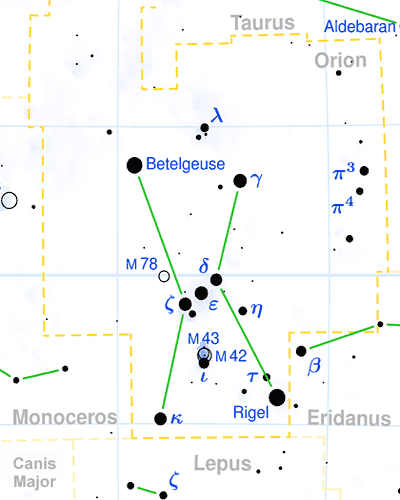
© Torsten Bronger CC BY-SA 3.0
2
3
4
5
6
7
8
9
10
11
12
13
14
15
16
17
18
19
20
21
22
23
24
25
26
27
28
M43
M78
Betelgeuse
Rigel
Bellatrix
Alnilam
Alnitak
Saif
Mintaka
Nair al Saif
Pi-3 Orionis
Eta Orionis
Meissa
Pi-4 Orionis
Sigma Orionis
Pi-5 Orionis
Omicron-2 Orionis
Mu Orionis
Pi-2 Orionis
Chi-1 Orionis
Nu Orionis
Xi Orionis
Thabit
Chi-2 Orionis
Pi-1 Orionis
Pi-6 Orionis
Omicron-1 Orionis
De Mairan's Nebula
N/A
"Armpit"
"Foot"
"Warrioress"
"Middle of the Belt"
"East End of the Belt"
"Hilt of the Sword"
"West End of the Belt"
"Bright One of the Sword"
N/A
N/A
"Shining"
N/A
N/A
N/A
N/A
N/A
N/A
N/A
N/A
N/A
"The Endurer"
N/A
N/A
N/A
N/A
Reflection Nebula
Reflection Nebula
Red Supergiant Star
Triple Star System
Blue-White Giant Star
Blue Supergiant Star
Blue Supergiant Star
Blue Supergiant Star
Binary Star System
Blue Giant Star
Yellow-White Dwarf Star
Multiple star System
Blue-White Giant Star
Binary Star System
Multiple Star System
Blue-White Giant Star
Orange Giant Star
Multiple star System
White Dwarf Star
Binary Star System
Triple Star System
Blue-White Dwarf Star
Blue Subgiant Star
Blue-White Supergiant Star
White Dwarf Star
Orange Giant Star
Red Giant Star
9.00
8.30
0.50
0.13
1.64
1.69
1.77
2.09
2.23
2.77
3.16
3.42
3.54
3.67
3.80
3.90
4.09
4.30
4.35
4.39
4.42
4.45
4.62
4.63
4.64
4.70
4.75
Orion contains a number of bright stars, including two of the ten brightest stars in the sky. Rigel is the brightest with a visual magnitude of 0.13. It is also the sixth brightest star in the sky. Rigel is a triple star system whose primary member is a blue supergiant. This massive star is 85,000 times brighter than the Sun and is located 863 light years away. Betelgeuse is the second brightest star in Orion and the tenth brightest star in the sky. It is a red supergiant star with a magnitude of 0.50. It is 100,000 times brighter than the Sun and is located approximately 643 light years away. Bellatrix is the third brightest star with a magnitude of 1.64. It is a blue-white giant star that lies approximately 240 light years from our solar system.
Orion contains three Messier objects. The sword of Orion is the home of the famous Orion Nebula, also known as M42. This nebula is one of the brightest in the sky and can easily be seen with the naked eye. It is also one of the nearest areas of active star formation to our solar system. M43, also known as De Marin’s Nebula, is another star-forming region connected to the Orion Nebula. M78 is a reflection nebula that can easily be seen in small telescopes. In addition to the Messier objects, Orion contains a number of other notable deep-sky objects. The Horsehead Nebula is a region of dark dust against a bright nebula. It gets its name from its shape that resembles that of a horse head. Barnard’s Loop is an emission nebula that forms a large arc nearly 300 light years in diameter. The Flame Nebula (NGC 2024) is an emission nebula illuminated by the blue supergiant star Alnitak located in Orion’s Belt. The Monkey Head Nebula (NGC 2174) is an emission nebula that gets its name from its unusual shape.
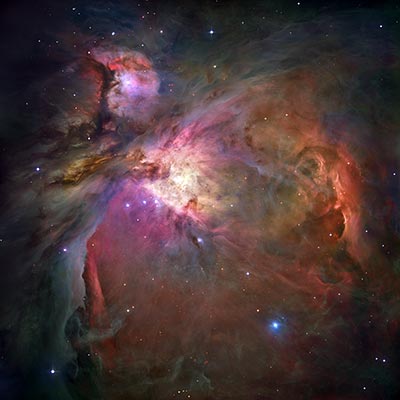
the Hubble Space Telescope
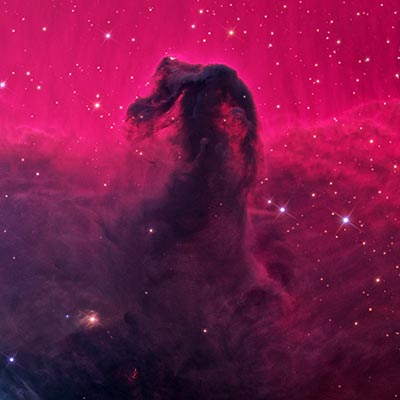
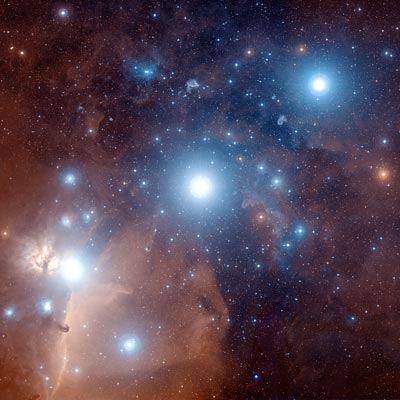
the Hubble Space Telescope.
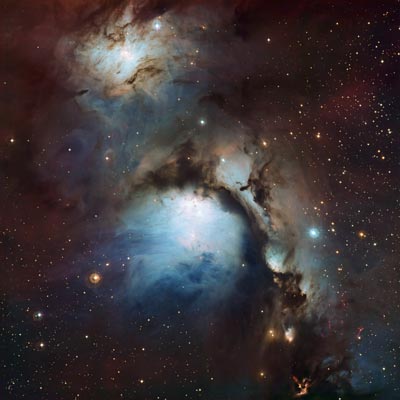
© ESO/Igor Chekalin CC BY 4.0



